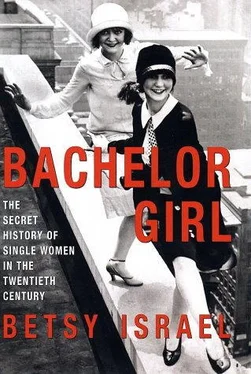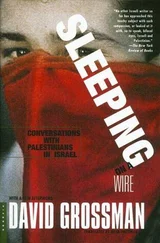A mistrust of female communality turns some unexpected corners. Bronson Alcott summed up the patriarchal view when he said of Louisa, “She has involved herself with a group of women who are ridiculed and condescended to…. she [will be] tolerated as an eccentric… a faded woman… fit only for the fringes of family and social life.” But some early feminists objected, too. Mary Wollstonecraft, author of what would become the feminist constitution On the Vindication of the Rights of Woman (1792), worried that women together were forming “unnatural organizations,” behaving without regard to the outside world, and thus developing a “grossness,” too great a degree of “intimacy,” among one another that would make it impossible for them to function as adult women the world would take seriously. Writer Eliza Lynn Linton, circa 1875, referred to shared group houses, or any too-close female organization, as “the shrieking sisterhoods.”
The sound of women talking together—gossiping, chattering, even whispering—seems always to have evoked negative images, shrieking or otherwise. Nathaniel Hawthorne complained famously of the many hack women writers, “damned scribblers,” as he called them, whose dreadful blathering books outsold his own. He often added to his usual tirade the secret belief that they worked somehow together, having masterminded a female word machine. “They speak endlessly to one another in private letters and they keep diaries which they are only too pleased to have others read out loud.” The Strand magazine, in 1894, only hinting at satire, called for the reinstatement of the brank, or gossip’s bridle, a sixteenth-century device that was, until 1824, used to “silence the talkative shrew.” The brank or branks consisted of an iron framework that locked like a helmet onto a woman’s head. Attached to the front was a small metal flap, or “gag,” that was inserted into the woman’s mouth so that she could not move her tongue. The bridle had extra features. The sharp gag was positioned so that if our shrew spoke at all, her tongue would be slashed.
The paranoid belief that women, when gathered in groups, will plot gossip, using words as Amazons used their weapons, is a recurring theme throughout history.
A fascinating document of this dread is a little-known 1916 antiabortion film called Where Are My Children? In this story, a small-town district attorney prosecuting a doctor for performing a deadly abortion learns that the doctor has performed abortions on many single women the lawyer knows—in fact, he’s assisted married women and, as it turns out, most of the women in the town. It soon becomes clear that the local women have for years secretly helped one another to terminate pregnancies, passing the doctor’s information around like contraband. One member of this underground network is the lawyer’s wife, who may have had an abortion and, like all others in her spy circle, without telling her husband . The thought of abortions was awful enough. [4] The corollary of the single woman who refused to bear healthy white children was her married contemporary who sought ways to abort unwanted children. During the mid-nineteenth century, in the decades just before the abortion outlaw, a common image in the American press was “the Aborting Matron,” a piggy, self-satisfied wife downing poison or else portrayed as demonically possessed.
But worse almost was the thought of women plotting together to control their fertility. The lawyer, played by Tyrone Power, Sr., seems about to break down. To comfort himself, he declares that if women pose such “a danger to mankind,” they will be monitored. Male spies will be turned on the crazy female spies, and they will stop them! And their antisocial insanity.
Single women in particular were often written off as crazy. “Their talkativeness, violation of conventions of feminine speech, and insistence on self-expression…. [that] was the kind of behaviour… that led to their being labeled ‘mad,’” writes scholar Elaine Showalter. Although it was impossible to prove, it was often said that single women in the late nineteenth century made up more than half the population of mental institutions.
By the 1960s, when critic Elizabeth Janeway revisited female collectivity, incessant chattering and potential madness no longer seemed to be the issue. The problem, as she saw it, lay in the social distancing of “unwanted unloved tribe(s),” whether single women, homosexuals, or any excluded group. Stuck together in a quarantined state, group members began to “externalize” or project their self-hatred onto outsiders. And the same dynamic would often work inside the group itself. In this self-loathing and paranoia she foresaw the spread of internal anarchy and betrayal.
The Women, George Cukor’s 1939 film version of the Clare Boothe Luce play, more enjoyably makes the same point. True, the characters technically are married, but we never see the husbands; the women act as though the men don’t exist and spend their days wandering from home to store to spa in a state of heavily subsidized singledom. With little to do, without connection to the larger world, they live to gossip and to plot against one another. The Women, both as play and film, turns verbal sparring into a spectator sport, a fur-draped “pardon me ” teacup kind of wrestling match with destructive results. The idea of manless women turning on one another, proving that these women are vile and imbecilic, has endless appeal. Both Wendy Wasserstein and Julia Roberts have attempted to revive the play, and a campy new version debuted on Broadway in the fall of 2001.
LIVES OF THE LONE RANGERS
Let’s briefly examine the lives of three nineteenth-century single women—Louisa May Alcott, Clara Barton, and, with special emphasis, Florence Nightingale. They are all members of that traditional grade-school book-report list of famous women, the one that includes Eleanor Roosevelt, Madame Marie Curie, and Helen Keller, who was for years presented as the consummate female role model (deaf, dumb, and blind but through intensely hard work making the most of it). Each of these women had to wait miserably at home before starting her career at about age thirty. And all struggled for years with intense frustration, guilt, and heavy bouts of depression.
Florence Nightingale will live always on record as history’s greatest and bravest nurse, as well as one of history’s most effective medical reformers. But the brave “Lady of the Lamp,” unlikely heroine of the Crimean War and England’s most celebrated medical statistician, spent much of her life until age thirty-three battling her mother. Frances Nightingale was a rich, socially prominent woman who expected her daughters, Parthenope and the younger, more beautiful Florence (named for the city where she was born), to participate fully in the season’s activities—balls, concerts, visiting rounds—then to move on to the family’s winter estate and start up again. Florence loathed social life, the hours spent dressing and chatting and smiling, all of it engineered to culminate in her early marriage. Her only solace was in the lessons she had with her father, a Cambridge graduate who’d insisted on teaching both girls mathematics, Latin, Greek, and literature. At sixteen, Florence wrote in one of her many journals that she could happily spend the next year seated with her father in the library. That, however, was impossible; her mother, Florence wrote, was intent on “raising female slaves” she could marry off for good profit.
As she continued: “I don’t agree at all that a ‘woman has no reason—and not caring for anyone else—for not marrying a good man who asks her,’ and I don’t think Providence does either…. Some have every reason for not marrying, and… for these, it is much better to educate the children who are already in the world and can’t be got out of it, rather than to bring more into it.”
Читать дальше












